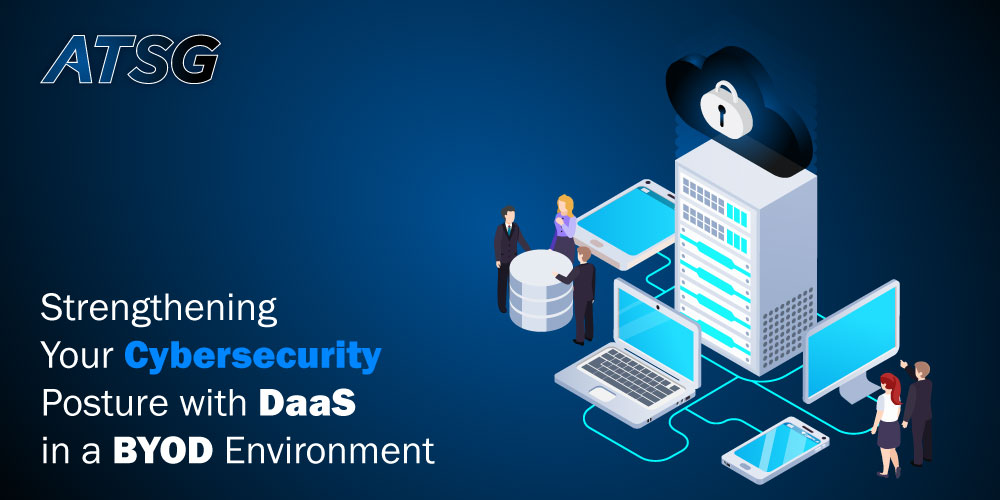Not too long ago, the thought of supporting policies like Work-from-Home (WFH) or Bring-your-own-device (BYOD) was not really taken seriously by many businesses. In fact, back then, many enterprises preferred the traditional ways of work. Today, things seem to have taken an interesting turn, as most businesses prefer flexible hybrid working environments.

Now, BYOD policies have brought about significant benefits to the workplace, such as increased productivity and flexibility. The problem however is that such policies also come with a fair share of security related challenges that can put valuable digital assets at risk. Luckily, Desktop-as-a-Service (DaaS) provides reliable solutions to enhance security in BYOD scenarios.
In this blog, we discuss how Desktop-as-a-Service (DaaS) can enhance security in Bring Your Own Device (BYOD) setups.
The Definition and Functionality of DaaS
As our world becomes more connected and mobile, many companies are embracing Bring Your Own Device (BYOD) policies to streamline their work processes. However, BYOD also presents significant security challenges that need to be addressed. That’s where Desktop-as-a-Service (DaaS) fits in perfectly.
Today, employees no longer have to be tied to their office desks, just to access work applications and desktops. With DaaS, work can be done from virtually anywhere, so long as there is a device with an internet connection. In other words, productivity is no longer confined to physical office spaces, giving employees the flexibility they need to achieve a lot more.
Centralized Data Management
There are many security related advantages of DaaS in BYOD scenarios. For starters, DaaS enables centralized data management, which means that sensitive information is stored in secure data centers, rather than individual devices.
But how can you securely implement DaaS in a BYOD environment? This is where the following best practices come in.
Regularly updating security policies: Enterprises must keep security policies up-to-date, to address the latest threats and vulnerabilities. This way, they can ensure that employees are trained on these policies.
Utilizing multi-factor authentication (MFA): Businesses must also use two or more authentication factors, such as passwords and biometrics, to strengthen access control and prevent un-authorized access.
Leveraging advanced threat detection and monitoring tools: Additionally, they should implement tools such as intrusion detection systems, firewalls and endpoint protection to detect and respond to threats in real-time.
Implementing encryption: With strong encryption, sensitive data can be protected from un-authorized access, particularly in BYOD scenarios.
Streamlined patch management: Patch management is also crucial in securing BYOD scenarios. Leading DaaS providers, like ATSG, offer Automated patch management, which ensures that all endpoints are updated with the latest security patches and software updates, thus reducing the risk of any vulnerabilities being exploited.
Gauging the Readiness of an Enterprise for DaaS
Here, a very important question arises that how can you implement DaaS in a BYOD environment? This should start by assessing your enterprise needs and readiness for DaaS. Once an enterprise is ready to move forward, choosing the right DaaS provider becomes crucial. Businesses must look for a provider that can deliver a secure and effective BYOD framework, like ATSG.
Another important factor to consider here is to see how DaaS will integrate with the existing IT infrastructure and systems of the deploying enterprise. This will help avoid any disruptions to business operations. In addition, adopting best practices can also help maximize security in DaaS-powered BYOD environments.
Conclusion
Amidst the constantly changing and challenging business landscape, enterprises with a hybrid workforce need a secure and dependable solution to “anchor” their data and operations.
Desktop-as-a-Service (DaaS) can be that “anchor”, providing a centralized, secure and efficient environment for managing and protecting data in bring-your-own-device (BYOD) scenarios.
So, for businesses looking to “stay afloat”, and keeping their mobile workforce running like a “well-oiled machine”, consider DaaS as a highly reliable solution to give you the required competitive advantage.
For businesses looking to implement secure BYOD policies, the good news is that ATSG’s robust Desktop-as-a-Service (DaaS) solutions can be your “go-to” option. With our highly scalable and agile DaaS solutions, you can stop worrying about the security risks associated with allowing your employees to use their own devices for work.
ATSG offers advanced and robust cybersecurity features like multi-layered security, strong built-in encryption, robust two-factor authentication (2FA), along with robust endpoint detection and response (EDR).
Say goodbye to the days of constantly worrying about monitoring and updating security policies, hoping that your employees would also be following the best practices. With ATSG’s DaaS solutions, your enterprise can enjoy a sense of security and confidence, knowing that your employee owned devices are fully secure, and that no sensitive enterprise data is stored over them.




